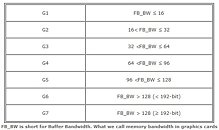- Joined
- Oct 9, 2007
- Messages
- 47,308 (7.52/day)
- Location
- Hyderabad, India
| System Name | RBMK-1000 |
|---|---|
| Processor | AMD Ryzen 7 5700G |
| Motherboard | ASUS ROG Strix B450-E Gaming |
| Cooling | DeepCool Gammax L240 V2 |
| Memory | 2x 8GB G.Skill Sniper X |
| Video Card(s) | Palit GeForce RTX 2080 SUPER GameRock |
| Storage | Western Digital Black NVMe 512GB |
| Display(s) | BenQ 1440p 60 Hz 27-inch |
| Case | Corsair Carbide 100R |
| Audio Device(s) | ASUS SupremeFX S1220A |
| Power Supply | Cooler Master MWE Gold 650W |
| Mouse | ASUS ROG Strix Impact |
| Keyboard | Gamdias Hermes E2 |
| Software | Windows 11 Pro |
One of the biggest consumer electronics markets, EU strictly regulates materials, radio-emissions, and energy-efficiency of consumer electronics items eligible for sale in its member states. A new such energy-efficiency regulation is taking shape that specifically mandates integrated graphics cores and discrete graphics cards to live up to certain energy standards. This has GPU maker AMD worried that it could affect next-generation chips, as they could be barred from sales in the EU.
The EU classifies graphics cards on the basis of on-board memory bandwidth, which is a reliable means of segregating the various market segments. The various classes are tabled below. The top tier "G7" is classified as graphics cards with 128 GB/s or above memory bandwidth. EU wants to cap graphics cards from achieving bandwidths above 320 GB/s (possible with 6.67 GHz at 384-bit width, or 5.00 GHz at 512-bit width). The EU sees memory bandwidth as proportionate to power-consumption. It's possible that the EU sees today's hardware more than sufficiently fast to handle games, and every new generation that increases performance does so with increases in power-consumption. With the sheer size of the EU market, GPU makers could be deterred from making low-volume high-performance products for the rest of the world as well.

View at TechPowerUp Main Site
The EU classifies graphics cards on the basis of on-board memory bandwidth, which is a reliable means of segregating the various market segments. The various classes are tabled below. The top tier "G7" is classified as graphics cards with 128 GB/s or above memory bandwidth. EU wants to cap graphics cards from achieving bandwidths above 320 GB/s (possible with 6.67 GHz at 384-bit width, or 5.00 GHz at 512-bit width). The EU sees memory bandwidth as proportionate to power-consumption. It's possible that the EU sees today's hardware more than sufficiently fast to handle games, and every new generation that increases performance does so with increases in power-consumption. With the sheer size of the EU market, GPU makers could be deterred from making low-volume high-performance products for the rest of the world as well.

View at TechPowerUp Main Site

 shadedshu:shadedshu
shadedshu:shadedshu










 EU will go thermonuclear
EU will go thermonuclear 